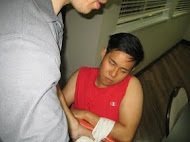What is the definition of a fracture?

A fracture refers to a broken bone, and in many cases, the words will be used interchangeably. There are many reasons why a fracture would occur, and this is what makes it important to learn the first aid tips for fractures. The most common causes of fractures are excessive trauma at the site of the injury or cases where there is excessive force exerted on the bone. It is also crucial to recognize the fact that in some cases, there are conditions which predispose individuals to the occurrence of fractures. When dealing with fractures, it is vital for the first aider to know that there are different types of fractures, all of which are unique in their presentation. Listed below are some of the more common types of fractures.
[youtube url=”https://www.youtube.com/watch?v=RDpEBmkV6xw”]– Open fractures occur when you have the bone peeking out of the skin, thus creating an open wound. The thing with these type of injuries is that they create a perfect opportunity for infection, making it imperative for first aiders to take caution when using First aid tips for fractures.
– The second type of fracture is known as the closed fracture, and this is characterized by the absence of an open wound.
– A complicated fracture is one which, just as the name describes, complicates the injury, leading to the damage of nervous endings as well as blood vessels within the affected region. Consequently, the victim could easily suffer sensation in the limb, leading to its amputation.
– Another category of fractures that you must be aware of when learning about First aid tips for fractures is the ‘greenstick fracture’. This is a term used to describe a condition that is prevalent in children where instead of causing afractures, the bone creates splints internally.
What are the symptoms that you should be on the lookout for?
– Pain within the site of injury
– Immobility in the affected region
– Swelling and redness of the affected area, although you may want to acknowledge that this does not always occur immediately.
– The area where the fracture has occurred will be tender to touch, one of the key First aid tips for fractures.
First aid procedure for fractures
i) Make sure that the area is as still as can be, instructing the victim not to move it.
ii) Check to see whether there are any open wounds or sources of bleeding. With the former, avoid moving the protruding bone. Instead, cover the wound with dressing to prevent introduction of infection.
iii) Surround the affected region with padding to cushion the victim against additional external force which could worsen the injuries.
iv) Make sure that you seek professional help to get the fracture addressed and prevent further injury.
Important notice in First aid tips for fractures
Call 911 when you cannot move the person at all. You must also take note of any color changes especially blue coloration as this is indicative that blood supply has been cut off within the affected area.
